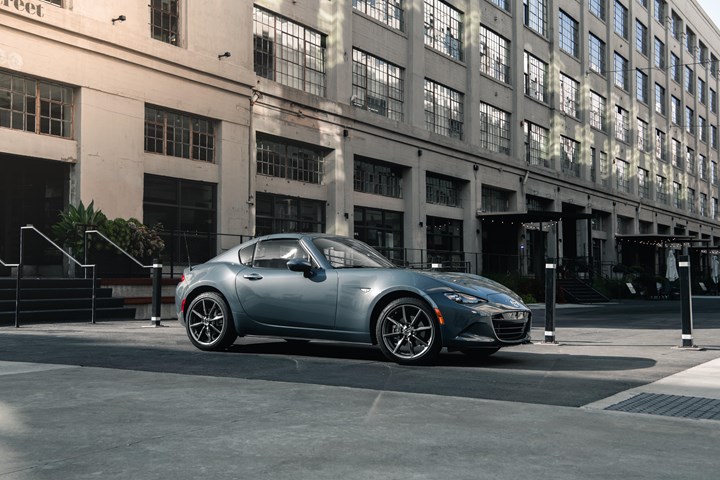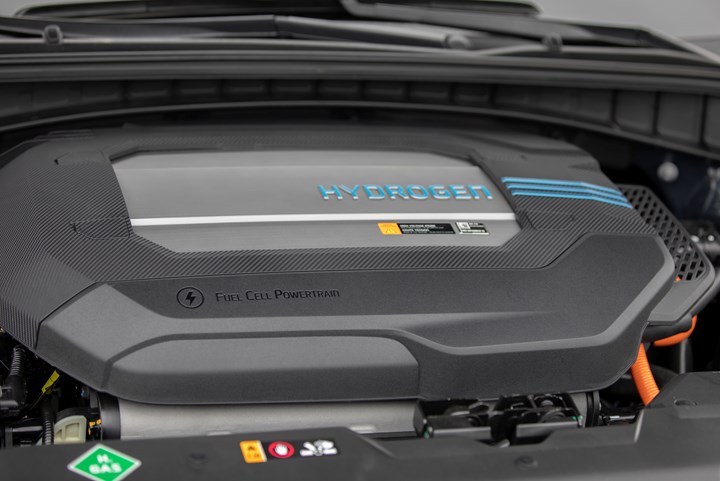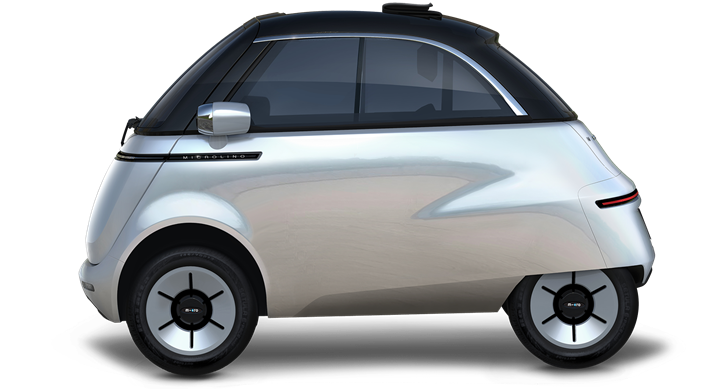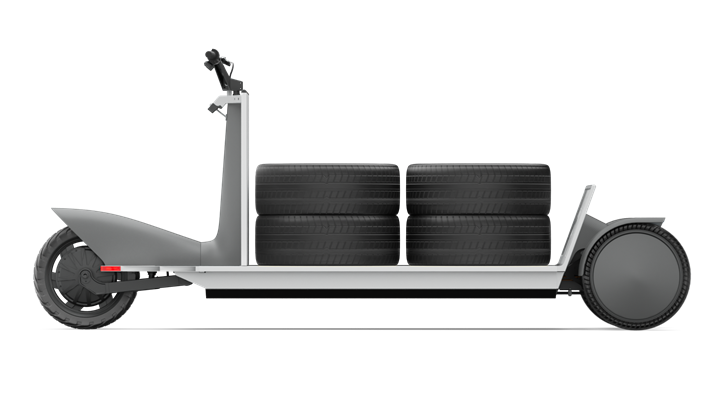On That New Car Smell, NAIAS, and The Microlino
The nose knows at Nissan (seriously). Creating new automotive experiences. Hyundai and hydrogen. And a whole lot more (including a reference to Henry Ford’s first four-wheel vehicle—and it isn’t the Model T).
This week On Automotive
- New Car Smell
- Beyond “Cars on Carpet”:North American International Auto Show
- 2021 Mazda MX-5 RF Grand Touring
- Keep An Eye On: Hydrogen
- Microlino: A Cute Quad
- By The Way… Take a look at the Microlino
- Electric Material Transport for the Last Mile
///
New Car Smell

Searching for that “new car smell.” (Image: Nissan)
The man in the photo above is Peter Karl Eastland. Eastland, who holds a master’s degree in Chemistry with Forensic Science from Leicester University in the UK, is presently the Odour Evaluation Lead Engineer at Nissan Technical Centre Europe.
Yes, he is smelling that steering wheel.
Nissan recognizes that people like the “new car smell” and part of Eastland’s job is to make sure that it is there.
Eastland: “We aim to provide the best sensory experience for the customer. While tastes and preferences evolve over time, smell remains a constant. Therefore, it is part of our job to make sure that any material we use is always going to be perfect in terms of scent and that all of the senses are harmonized.”
A Wholistic Approach to Smell
Explains David Moss, Nissan senior vice president, Region Research & Development, “That new car smell isn’t just a consequence of the manufacturing process; months of work are devoted throughout the development phase of the new vehicle to carefully analyze the use of materials and chemicals, such as seat fabric, adhesives, and polymers, to ensure that they don’t combine to generate an unpleasant odor for the car’s occupants.”
While it is not surprising that there are people whose job it is to assess things like textures, durability and resilience, and fit and finish of interior components, it is surprising that Eastland and his team work with Nissan engineering and manufacturing personnel to make sure that the materials being spec’d and used provide a positive. . .ambience.
///
Beyond “Cars on Carpet”

The GMC Hummer EV SUV: Going to Motor Bella. (Image: GM)
Even before the pandemic slammed the doors shut on auto shows nearly everywhere, show organizers had a problem.
The “experiential” problem.
An increasing number of people—especially those in a younger demographic—wanted more from auto shows.
Let’s face it: when you’re raised in an environment where the movies you see are from Marvel, unbelievable things are the norm.
But auto shows, by and large, were what industry insiders call “cars on carpet.”
A static showroom in an expo center.
The organizers of the North American International Auto Show, the Detroit Auto Dealers Association, had planned to stage an event—an experiential event where it wasn’t just a matter of “looking” at vehicles but also engaging with them—in June 2020 in and around downtown Detroit.
You know how that didn’t turn out.
But they’re going to try again, September 21-26.
This time at the M1 Concourse, a facility in Pontiac, Michigan, that has an impressive centerpiece:
A 1.5-mile road course.
The event: Motor Bella.
Experiential Elements
Yes, there will be some 400 cars, trucks and utilities on display.
On display on 87 acres of property.
But what is notable is the experiential part.
Like hot laps with professional drivers.
And street course rides on Woodward Avenue in electric vehicles.
(Bonus fun facts: Woodward is designated “M1,” which explains the name of the venue. But in the context of automobility, it was the first concrete paved road (at least a section was paved in 1909; the avenue runs some 21 miles from the Detroit River out to Pontiac). And it had the first three-lamp traffic signal installed in 1919 (with traffic signals on Woodward later being used like the Christmas tree lights on drag strips).)
As getting off pavement is becoming more popular, there will be opportunities to ride along in places that seem impossible for four wheels.
Yes, plenty of experiential activities.
(For those of a more technical slant, know there will be AutoMobili-D, an event dedicated to mobility innovations with tech from both existing suppliers and startups. It will be a two-day event, September 21-22.)
This is well beyond “cars on carpet.”
///
2021 Mazda MX-5 RF Grand Touring

MX-5 Miata: This is what fun looks like. (Image: Mazda)
The Mazda MX-5 Miata has been on the scene since 1989, and while the vehicle has most certainly evolved both stylistically and technologically, there is one thing that remains the same:
It is arguably one of the least functional vehicles you can drive.
Unless the function that you want the vehicle for is driving.
Then you’re not likely to be able to beat the Miata, especially from the point of view of price vis-à-vis the fun of driving.
The first thing to know about the Miata is that it is small. A two-seater. A small two-seater.
It is 154.1 inches long—including the license plate holder, as though that adds notably to the length.
It is 68.3 inches wide.
And the thing that you’re going to sense most of all when you climb into the cabin—which doesn’t require a whole lot in the way of leg lifting as it is just 5.3 inches above the ground—is that it is 49 inches high.
To put that into perspective:
In my part of the world, metro Detroit, there are plenty of Ford F-150s. Of course, that’s a statement that can pretty much be made for almost anywhere.
Taking, for example, a 2021 Supercab with a 6.5-foot box, know that the vehicle is 231.7 inches long, 79.9 inches wide, has a cab height of 77.2 inches, and a 9.4-inch ground clearance.
Let me tell you that driving on a freeway where there are plenty of F-150s—as well as Silverados and Ram 1500s—is something that results in a clenched anatomy.
It is not fun. It isn’t the car. It is the rest of the world. Where we have to drive on a daily basis.
But on a two-lane road with little traffic (or, conceivably, a track), something else entirely.
The sports car is powered by a 181-hp, 2.0-liter four; it is available with a six-speed manual or six-speed automatic. The power goes to the rear wheels.
I understand the “Save the Manual” campaign mounted by enthusiasts. I enjoyed the manual on the aforementioned two-lane. I wasn’t nearly as chuffed surrounded by pickups and SUVs. (I wanted all of my cognitive bandwidth dedicated to making sure someone didn’t make an unintended move, not doing that and putting it in gear.)
The version as-driven was just under $36K, all in.
The price of a base ticket to Disney World is $109 per day.
If the MX-5 is as much fun as I argue it is, then that means 330 days’ worth of tickets.
Obviously you wouldn’t spend nearly a year there. But having a Miata as a daily driver certainly isn’t out of the realm of possibility.
///
Keep An Eye On: Hydrogen

Under the hood of a Hyundai Nexo: This is what the future looks like. (Image: Hyundai)
“Hyundai Motor Group's vision is to apply hydrogen energy in all areas of life and industry such as our homes, work-places and factories. The goal is to make hydrogen readily used for everyone, everything, and everywhere. We want to offer practical solutions for the sustainable development of humanity and with these breakthroughs, we aim to help foster a worldwide Hydrogen Society by 2040.”—Euisun Chung, chairman, Hyundai Motor Group
Here’s the thing: Hyundai has a tremendous amount of powertrain development going on, whether this takes the form of efficiently burning fossil fuels or deploying electricity.
It launched a Tucson fuel cell electric vehicle (FCEV) back in 2013. It brought out the Nexo FCEV in 2018. And last year it launched the XCIENT, a FCEV big rig.
Some OEMs have hydrogen projects on the side. Hyundai is putting its hydrogen projects into vehicles that ordinary people can get into.
While Hyundai can be readily associated with things like Sonatas and Pallisades, it also has a commercial truck production operation.
It plans to have its entire commercial vehicle lineup available with hydrogen-power by 2028.
Observation: While the future is undoubtedly going to be electric vehicles, know that the electricity may be generated by fuel cells rather than at power plants.
///
Microlino: A Cute Quad

Bodyside die for the Microlino. (Image: Microlino)
The image above is a man and a die. The man provides scale. The die will be used to stamp the entire bodyside of the Microlino 2.0.
The what?
A mobility device—it is hard to call it a “car” despite it having four wheels, a steering wheel, seating for two, and 7.7-cubic feet of cargo capacity (the Mazda MX-5 has just 4.59).
The Microlino has an 11-kW electric motor that provides a maximum speed of 56 mph. Given that it measures 96 inches long, 59 inches wide, and 57 inches high and has a curb weight of 1,132 pounds, there are probably not a whole lot of people who will go that fast in the device.
It is classified as an L7e vehicle, which is a heavy quadricycle.
(Fun fact: Henry Ford’s first “automobile,” which was launched in 1896, was named the “Quadricycle.” Seems like we’re going back in time with things like the Microlino.)
The vehicle has a standard 8 kWh battery or an optional 14.4 kWh battery. Both are lithium nickel manganese cobalt oxide (NMC).
The range for the standard is an estimated 78 miles and 124 miles for the bigger battery.
The vehicle will be produced at the facility of CECOMP Spa in La Loggia, Turin, Italy. Microlino and CECOMP have established a company for that purpose: Microlino Italia..
CECOMP is an acronym for Centro Esperienze COstruzione Modelli e Prototipi. Even the non-Italian readers among us can see that “prototipi” in there: yes, the company specializes in prototype builds for the likes of Maserati, although it does serially produce another car you’ve probably not heard of, the Bolloré Bluecar, an electric city car.
According to a timeline on the Microlino site, production could commence within a week or two.
///
By the way. . .

This is a real vehicle. A road-worthy quadracycle. (Image: Microlino)
This is what the Microlino looks like.
According to the manufacturer it offers seating for two adults and “three beer crates.”
Given its dimensions it, apparently, can be parked so that the door opens onto a sidewalk.
With the larger, 14.4-kWh battery, the range, based on a European motorcycle test protocol, is 124 miles.
By way of comparison (arguably unfair as this is a five-passenger vehicle with 16.6 cubic feet of storage which can presumably handle at least three beer crates), the Chevy Bolt, with its standard 65-kWh battery, on the EPA passenger car cycle, has a range of 259 miles.
///
Electric Material Transport for the Last Mile

The driver would be standing on the left side of the vehicle, using the “handle bars” for steering. (Image: Polestar)
While on the subject of vehicles with. . .quirky designs, Polestar is moving ahead with the “last-mile delivery vehicle,” Re:Move, as it has introduced a working prototype of the vehicle that was created as a collaboration between the OEM; Konstantin Gricic, an industrial designer known for his minimalist approach to objects; CAKE, a producer of electric motorcycles; and Hydro, an aluminum supplier.
Although the Re:Move has a top speed of just 15 mph, the development is going fast: the design study was announced in March 2021.
The objective of the vehicle is to provide last-mile delivery capability in both urban centers as well as in areas where there isn’t extensive infrastructure.
Dimensions
- Width: 29 inches. Sized for Euro bike lanes
- Cargo capacity: 400 pounds
- Turning circle: <23 feet. There is an electric-tilt mechanism that allows leaning into turns while keeping the vehicle stable.
Features
- 2.2-kWh battery and hub motor from CAKE
- Disc brakes
- Front lighting and brake lights
Quotes
- “Electrifying vehicles is the start point, not the end game.”-- Thomas Ingenlath, Polestar CEO
- “Good design is inherently sustainable design.”-- Konstantin Grcic
- “With the obligation to inspire towards zero emissions, Re:Move defines a new vehicle category.”--Stefan Ytterborn, CAKE Founder and CEO
- “Re:Move is not only a low maintenance vehicle with an electric powertrain, but it’s also fully recyclable and uses low carbon aluminum that is made with renewable energy.”-- Bjørn Kjetil Mauritzen, Head of Sustainability at Hydro
RELATED CONTENT
-
Jeeps Modified for Moab
On Easter morning in Moab, Utah, when the population of that exceedingly-hard-to-get-to town in one of the most beautiful settings on Earth has more than doubled, some people won’t be hunting for Easter eggs, but will be trying to get a good look at one of the vehicles six that Jeep has prepared for real-life, fast-feedback from the assembled at the annual Easter Jeep Safari.
-
TRW Multi-Axis Acceleration Sensors Developed
Admittedly, this appears to be nothing more than a plastic molded part with an inserted bolt-shaped metal component.
-
Cobots: 14 Things You Need to Know
What jobs do cobots do well? How is a cobot programmed? What’s the ROI? We asked these questions and more to four of the leading suppliers of cobots.


.jpg;width=70;height=70;mode=crop)






